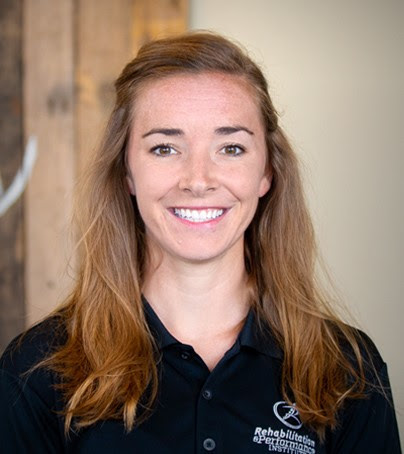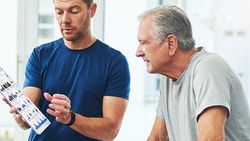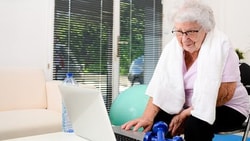How I Learned to Embrace RTM Billing by Focusing on Patient Outcomes First
Learn how one physical therapist’s journey with Remote Therapeutic Monitoring led to extra benefits for patient outcomes and streamlined billing for the work they were already doing with patients.
June 17, 2025
7 min. read

My remote therapeutic monitoring (RTM) journey began almost by accident after I was invited to join a change-management team at Rehabilitation & Performance Institute, where I work. I was asked if I could take charge of our RTM pilot and start incorporating it with my patients. I was already doing these activities anyway, like checking in on patients and monitoring adherence, so I figured ‘why not?'. But when we started using RTM back in 2022, I was learning the technology as I went, not sure where it would lead.
I wish I could tell you that everything went smoothly the first time I presented on RTM during an in-service, but here’s the reality: it was a train wreck. My colleagues and I had only been using RTM for about a month, and I think we only succeeded at confusing our clinicians even more.
But even then I could see the potential of RTM, if I could just get the hang of it—I realized it was just a matter of embracing the learning curve and getting comfortable with the technology. At first it was a bumpy road, but over time I learned what worked and what didn’t. So when I led my next in-service, it went much better. I was able to share what I learned through trial and error, and I was able to help other clinicians have a better experience during their first time using RTM. After getting our clinicians on board with RTM, we’ve seen an uptick in patient usage in the Medbridge reporting dashboard.
Since then, it’s been my goal to improve RTM adoption for better patient outcomes and streamlined billing. But it also taught me a few important lessons about the challenges clinicians face when billing with RTM.
Remote Therapeutic Monitoring: Your Guide to Successful Billing
Fill out the short form to unlock your free RTM Billing Guide PDF!

Tip #1: Embrace the Learning Curve and Get Comfortable with the Technology
First, it’s important to encourage practices to give clinicians dedicated time during the week to familiarize themselves with RTM. Comfort with technology is the foundation of RTM success, and nobody is an expert in technology from day one—except maybe a toddler with an iPad.
Next, suggest that leaders promote ongoing training to boost clinician confidence. This can range from informal peer sessions, to more structured learning like Medbridge's Digital Health Academy. You’ll know what works best for your team, but resources like this can help you develop a framework and give you a head start.
Tip #2: Keep the Patient Experience Simple and Engaging
When I talk to my patients about their exercise program, I’m careful about how much technical information I bombard them with. That’s why I try to give therapists permission to not make things too complicated when setting patients up with RTM.
To help clinicians keep it simple with their patients, I advise leaders to help them streamline patient communications by minimizing the amount of technical details that might otherwise become a barrier.
Then, I highlight the value of the “security blanket” benefit of having the app, especially for older patients. Often patients are so preoccupied with taking notes or trying to remember their exercises that they lose focus on the home program themselves. I tell them to relax, and that they’ll have access to all their information in the Medbridge app, or if they prefer, a handout.
There’s a stereotype that older patients can’t or won’t use technology, but I’ve found that the opposite is often true: they’re thrilled that they have all their exercises and education in one convenient place, and like that they can revisit it whenever they need a refresher. Research also shows that patients 65 and older are not only willing to engage with healthcare technology, but benefit a lot from it. Not every patient will want to use an app, and some just prefer to stick with printed handouts, but how do we know that unless we give them the chance?
Tip #3: Flexibility in Scheduling and Clinician Workflow
As a busy PT, finding time to focus on RTM was initially a challenge. I changed this by modifying my schedule to block off dedicated time during the week to manage patient messages, follow-ups, and focus on RTM.
One way clinics can help their clinicians succeed is to similarly build dedicated time blocks so clinicians can catch up on RTM tasks without feeling overwhelmed. But it's also important to remain flexible—the patient is always the priority, so if a clinician who’s new to the process misses out on an RTM opportunity here or there, it’s not the end of the world. And in the end, that little bit of flexibility can lead to better adherence without sacrificing overall productivity.
Tip #4: Simplify RTM Billing—Focus on Patient Outcomes First
Your patient’s focus should be on their program, not on RTM billing codes. You wouldn’t begin a manual therapy technique by telling your patient what code you’ll be billing this under, so why would RTM be any different? Present hybrid care apps like Medbridge as the gold standard and present that to the patient as part of their program.
Again, urge clinic administrators to allow clinicians to concentrate on the patient side first and worry about billing details later, especially in the beginning. Administrative support is great for that part if you have them on staff! You can also help set up systems so that billing processes are as automated and uncomplicated as possible. It’s a little extra work in the beginning to set up, but it really helps simplify things for yourself and your patients in the long run.
Tip #5: Utilize Support Staff to Enhance Patient Setup and Engagement
Speaking of administrative support, front desk or patient service specialists are a great resource to get patients set up on the Medbridge app before their visit!
By training support staff to handle the initial patient setup, it frees up clinicians to focus on care. This team approach reduces friction and increases the likelihood that patients will adhere to their program and the RTM process.
Tip #6: Continuously Monitor, Share Feedback, and Adapt
Patient feedback is a great way to validate the RTM process and encourage reluctant patients or colleagues. One of the biggest barriers is the simple fact that change is hard and clinicians are busy! But demonstrating that RTM really works goes a long way to winning over skeptics and showing that patients and clinicians will benefit from the extra couple of steps.
Clinics should periodically review RTM data and clinician feedback to pinpoint successes and areas for improvement. You can also reinforce that transparency by sharing tips and lessons learned to create a culture of continuous improvement. Sharing small wins and patient stories is also a great way to show that the work everyone is putting into RTM is making a real impact on patient lives.
Conclusion
At the end of the day, you’re going to get out of RTM what you put into it, so encourage your clinic leaders to support their teams in implementing these strategies. You’ll be amazed at how small boosts to patient engagement and billing reimbursement add up over time. You’re already doing the critical work with your patient—you might as well take full advantage of the extra benefits of Remote Therapeutic Monitoring!
If you’re looking for a place to get started, Medbridge has great resources in their Digital Health Academy, as well as built-in RTM capabilities as part of Medbridge Care.





